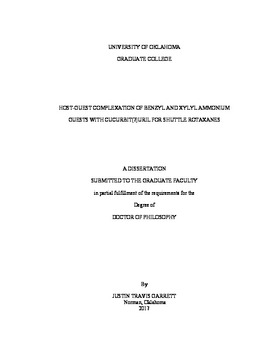| dc.contributor.advisor | Halterman, Ronald | |
| dc.contributor.author | Garrett, Justin Travis | |
| dc.date.accessioned | 2017-12-04T19:34:04Z | |
| dc.date.available | 2017-12-04T19:34:04Z | |
| dc.date.issued | 2017-12 | |
| dc.identifier.uri | https://hdl.handle.net/11244/52720 | |
| dc.description.abstract | Bistable rotaxanes are considered to be important design elements of molecular devices for a wide range of applications, such as controlled drug release, molecular machines, and molecular sensors and shuttles. The interest in molecular shuttles comes from the possibility of achieving controlled submolecular motion of their components with respect to each other. Cucurbiturils have become highly attractive for such applications due to their affinity to form host–guest complexes with ammonium and diammonium salts and have also been used for the construction of supramolecular assemblies that demonstrate intriguing structural, and functional properties. However, little research has been conducted to explore the use of cucurbituril, in particular cucurbit[7]uril (CB[7]), as a molecular shuttle within a rotaxane based molecular sensor. Our aim was targeted to expand the scope of CB[7] host-guest chemistry for shuttle rotaxanes (i) by developing suitable binding guests equipped with efficient stoppers and (ii) by investigating rotaxane formation under mild conditions.
A series of benzyl ammonium analogues incorporating bulky end groups (diisopropyl) and variable groups at the para position were synthesized for usage as suitable rotaxane binding stoppers. The host-guest complexes between CB[7] and the benzyl ammonium analogues were analyzed in competition binding experiments with NMR spectroscopy. The 1:1 equilibrium binding constants show binding affinities of Ka = 10^5 M^-1.
Supramolecular complexes between CB[7] and select 4,4’-dipyridiunium dications (viologens) containing sizeable end groups were explored with the intent to sterically block CB[7] from forming a full inclusion complex. When the larger end groups (3,5-diisopropoxybenzyl) were present, the CB[7] could only form a transient complex at the periphery even after heating to 80 °C for 24 h. Lastly, rotaxane formation with a benzyl ammonium stopper containing a terminal alkyne and a benzyl azide via copper (Cu)-catalyzed azide-alkyne cycloaddition (CuAAC) was explored to provide a model rotaxane to examine stopper efficiency against CB[7] encapsulation. The CB[7] was shown to pass over the bulky end groups of the benzyl ammonium resulting in the formation of an inclusion complex. Xylyl diammonium analogues containing various sizes of endgroups were also explored to confirm stoppering efficiency against CB[7]. Host-guest complexes with CB[7] and the xylyl diammonium analogues were analyzed in competition binding experiments and had shown strong binding affinities with 1:1 equilibrium binding constants of Ka = 10^9 M^-1. | en_US |
| dc.language | en_US | en_US |
| dc.subject | host-guest chemistry | en_US |
| dc.subject | rotaxane | en_US |
| dc.subject | binding constants | en_US |
| dc.subject | cucurbituril | en_US |
| dc.subject | Chemistry, Organic. | en_US |
| dc.title | HOST-GUEST COMPLEXATION OF BENZYL AND XYLYL AMMONIUM GUESTS WITH CUCURBIT[7]URIL FOR SHUTTLE ROTAXANES | en_US |
| dc.contributor.committeeMember | Glatzhofer, Daniel | |
| dc.contributor.committeeMember | Nicholas, Kenneth | |
| dc.contributor.committeeMember | Yip, Wai Yak | |
| dc.contributor.committeeMember | Bumm, Lloyd | |
| dc.date.manuscript | 2017-11 | |
| dc.thesis.degree | Ph.D. | en_US |
| ou.group | College of Arts and Sciences::Department of Chemistry and Biochemistry | en_US |
| shareok.orcid | 0000-0003-4781-6616 | en_US |
| shareok.nativefileaccess | restricted | en_US |
